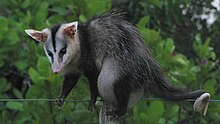| White-eared opossum[1] | |
|---|---|

| |
| Scientific classification | |
| Domain: | Eukaryota |
| Kingdom: | Animalia |
| Phylum: | Chordata |
| Class: | Mammalia |
| Infraclass: | Marsupialia |
| Order: | Didelphimorphia |
| Family: | Didelphidae |
| Genus: | Didelphis |
| Species: | D. albiventris
|
| Binomial name | |
| Didelphis albiventris Lund, 1840
| |

| |
| White-eared opossum range | |
| Synonyms[3] | |
|
List
| |
The white-eared opossum (Didelphis albiventris), known as the timbu and cassaco in northeast Brazil, saruê and sariguê in Bahia, micurê and mucura in northern Brazil[4] and comadreja overa in Argentina,[5] is an opossum species found in Argentina, Bolivia, Brazil, Paraguay, and Uruguay.[6] It is a terrestrial and, sometimes, arboreal animal, and a habitat generalist, living in a wide range of different habitats.[6]
For some time, this species was incorrectly known by the name D. azarae, correctly applied to the big-eared opossum. This led to azarae's discontinuation as a species name.[1] From 1993 until 2002, this species also included the Guianan white-eared opossum (D. imperfecta) and the Andean white-eared opossum (D. pernigra) as subspecies.[1]
It is the team mascot of Clube Náutico Capibaribe, a Brazilian football team from Recife, Pernambuco.[7]
- ^ a b c Gardner, A.L. (2005). "Order Didelphimorphia". In Wilson, D.E.; Reeder, D.M (eds.). Mammal Species of the World: A Taxonomic and Geographic Reference (3rd ed.). Johns Hopkins University Press. p. 5. ISBN 978-0-8018-8221-0. OCLC 62265494.
- ^ Costa, L.P.; Astúa, D.; Brito, D.; Soriano, P.; Lew, D. (2021). "Didelphis albiventris". IUCN Red List of Threatened Species. 2021: e.T40489A197310863. doi:10.2305/IUCN.UK.2021-1.RLTS.T40489A197310863.en. Retrieved 13 November 2021.
- ^ Gardner, Alfred L. (2007). Mammals of South America Volume 1 Marsupials, Xenarthrans, Shrews, and Bats. Chicago 60637: The University of Chicago Press. ISBN 978-0-226-28240-4.
{{cite book}}: CS1 maint: location (link) - ^ "Timbu - Informative". Tibau du Sol. Retrieved 28 July 2021.
- ^ "Comadreja overa, una especie protegida de la fauna provincial". Gobierno de la Provincia de Mendoza. Retrieved 20 November 2021.
- ^ a b Eisenberg, John F.; Redford, Kent H. (2000). Mammals of the Neotropics: Ecuador, Bolivia and Brazil.
- ^ "Simbolos | Clube Nautico Capibaribe". Archived from the original on 2014-08-14.
